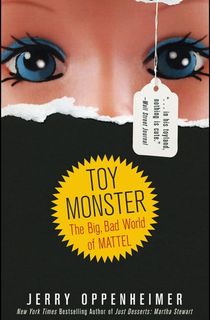Though we normally associate toys with childhood innocence and imaginative fun, Barbie has long been a controversial figure. Her unrealistic body and penchant for accessories have regularly rankled feminists, and famously inspired Marge Piercy’s poem “Barbie Doll” in 1971.
However, the Barbie controversy runs even deeper than most realize. While Ruth Handler is credited as the inventor of Barbie, bestselling author Jerry Oppenheimer has dug into a more salacious figure at Mattel who claims much of the credit: the "Father of Barbie," designer Jack Ryan.
Below, read an excerpt from Toy Monster to learn a little more about Mr. Ryan and his tenure at Mattel. And to discover far more about the iconic company and its shocking history, download the novel now.
Chapter 5
Real-Life Barbie Dolls
The Father of Barbie adhered to a libertine philosophy in his personal life at The Castle and in his professional life at Mattel, where he hired young, pretty women because he believed his designers and engineers would be more creative and thrive if there were gorgeous females in view, all of which raised eyebrows with the Handlers.
“Jack would say, ‘Why do you think airplanes have such pretty stewardesses? It makes people relax, takes their minds off of fear of flying. ’ He just felt that men are the best they can be if there’s a pretty female in their midst,” relates Nancy Hudson, who was a perky 29-year-old suntanned, platinum blonde divorcee who favored micro-miniskirts and high heels when she was hired to work for Ryan as a secretary.
Jack had to find women who knew how to look good all by themselves and all the time. A woman who could really type and take shorthand wasn’t what he cared about. He liked somebody who was more sparky.
Mattel wanted to keep Jack happy. He operated pretty independently, so whatever arrangement worked for him was okay. The Handlers looked upon Jack as creative and inventive and a genius and they weren’t going to enforce a corporate culture on him. Whoever Jack wanted to hire was fine with them.
At the same time, Ryan had enormous respect for the intelligence of women. “Women’s work isn’t given the proper value, and, as a result, they get angry,” he espoused. “More than that, they try to become amateur men. The thinking process of women is quite different from men, and we should recognize that—and also recognize its probable superiority.”
Jack adored Hudson, though she points out they were never romantically involved. They became “close buddies” during her seven-year tenure at Mattel and after, when she began helping out at The Castle, where Ryan had established his own private R&D think tank, called the Jack Ryan Group. For one of Hudson’s birthdays, Jack threw a little celebration at Mattel and presented her with a three-quarter-length white mink coat. He also paid for her group-therapy sessions with his psychiatrist, Dr. Marvin Klemes, and Ryan took Hudson, Annie Constantinesco, and another beauty named Charlie on an all-expenses-paid vacation in Acapulco.
“Jack was an extremely generous man,” notes Hudson.
Gwen Florea, the first Voice of Barbie, was another example of Ryan’s philosophy of hiring the best and most beautiful.
She was an aspiring actress and part owner of a rowdy Santa Monica bar called the Oar House when the Father of Barbie’s brother, Jim, spotted the statuesque redhead bumping and grinding barefoot to the music of “The Stripper” atop the bar—barely clad in what she later described as “hip-hugging blue jeans that are almost a G-string, and a red halter top barely covering her jiggling breasts . . . like a Barbie doll come to life.” Jack came to see her in action and immediately ordered Jim, who was married and a known womanizer himself, to recruit Florea for a job in Mattel’s recording studio and acoustics lab, which Jim headed.
The Ryans wanted her at Mattel not only for her looks, but because she had conceived an amazing sound system in the Oar House with a tape of eclectic music and booming sound effects, ranging from a roaring steam engine to a flushing toilet. “How much are you making?”
Jim Ryan asked her. Before she could answer, he told her, “We’ll double it.”
Keep Reading: Download Toy Monster now.

Toy Monster
“Oppenheimer takes a tour of Mattel’s seamier side, highlighting its dubious corporate practices and kooky cast in this scathing portrait . . . Fast-paced and engaging, this exposé will absorb readers until the last page and will forever change the way they think about the company.” —Publishers Weekly
